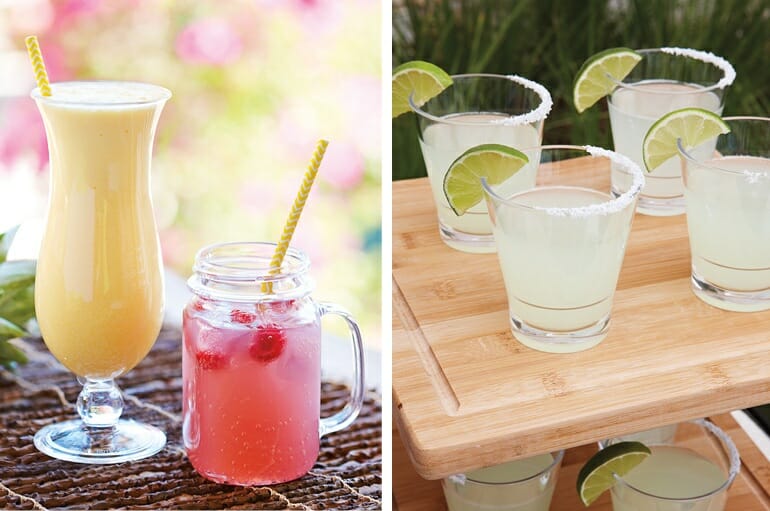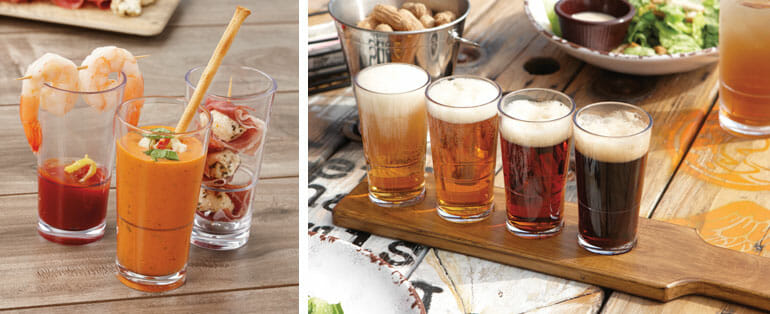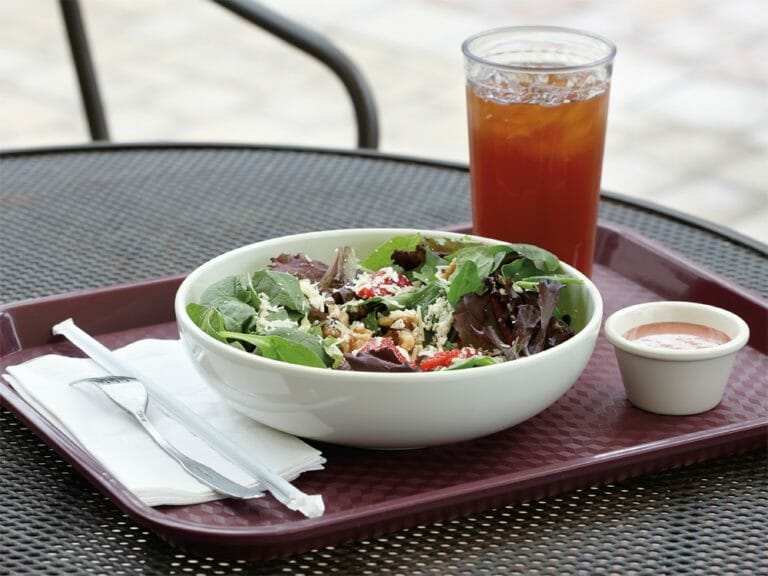Drinkware for Foodservice: Key Attributes to Consider When Buying
Whether you’re a first-time foodservice operator opening your premier location, or you’re a 30-year veteran who’s interested in overhauling your drinkware program, taking a few key attributes into consideration can help you make the best drinkware purchase for your establishment. Generally, knowing what you want in terms of ounce capacity, material (PC, SAN, or Tritanª plastics, or glass), and segment use cases will help guide you to the best products for your needs.
Ounce Capacity and Beverage Service Pricing for Commercial Drinkware
The most commonly used drinking glasses in commercial foodservice are 8, 12, 16, 24, and 32 oz. You should know your optimal ounce capacity because drink service – both adult beverages and non-alcoholic drinks – offers some of the best margins in a notoriously margin-tight industry. Look to your competitors to see how your pricing and ounce capacity will match up.

Pictured: 8808-1-CL, SW-1512-CL, S-17-CL, 2224-1-CL, 9932-1-CL
For example, if your competitor down the street is selling a 20 oz. soda for $1.50, and you’re selling the same drink in a 16 oz. glass for $2.00, you may lose sales to your competitor. If that happens, beverage service’s cushy profit margin won’t help you to offset high food costs.
It’s not only about the size of beverage you’d like to offer. To find the sweet spot for your brand, you’ll want to consider:
- How your drink prices and ounce capacities compare to your competitors’
- Whether you offer free refills, and the cost to do so vs. the marketing and operational benefits
- How your drink prices supplement your food costs
Whatever your brand positioning and guest expectations are, knowing your optimal ounce capacity and price point are good places to start narrowing down your drinkware options.
Not finding the answers you want? Leave a comment telling us what we’re missing and we’ll cover it for you.
Durability of Drinkware Material – Plastic vs. Glass
With modern materials, design, and manufacturing capabilities, foodservice operators can now find plenty of drinkware options in plastic that were previously only available (or only looked good) in glass. This is excellent news because it broadens the horizon of possibilities regarding drinkware materials, which in turn offers operators improved:
- Durability – can withstand chipping better than glass
- Safety – won’t shatter or create dangerous chipped edges like glass
- Service life, saving money long-term – plastic drinkware’s annual replacement rate, when following proper care and maintenance, is 10%-20% while glass may require 50%-150%
Glass drinkware is still an excellent choice and may be best for some foodservice operations. The key takeaway here is that if you’re on the fence between plastic and glass, you now have excellent plastic drinkware options that can support a range of brand styles and levels of formality.
Because plastic drinkware is less prone to chipping than glass, it increases the safety of your guests and staff. This can turn into real savings for foodservice operators due to lower workman’s comp bills, injury claims from guests, and steady productivity because you won’t need to temporarily cover for an injured staff member.

Pictured: SW-1462-PC-CL, SW-1435-CL, SW-1463-PC-CL, SW-1429-1-SAN-CL, SW-1407-1-SAN-CL, SW-1434-CL, GOB-15-PC-CL
If you’re interested in plastic, the most popular kinds of food-safe plastics are PC (polycarbonate) and SAN (styrene-acrylonitrile). They’re both good options, but have different qualities you should consider before deciding on one over the other:
- An Eastman-Kodak study shows PC tends to get cloudy after 100 washes, and can crack at around 250 washes in a commercial dishwasher while SAN still looks great after 1,000. This means you may need to replace PC drinkware at 10x the rate of SAN
- PC contains BPA as part of its inherent composition (it can’t be removed) and SAN does not
- SAN is prone to chipping if dropped (but still performs better than glass) while PC can withstand a good deal of dropping before cracking, chipping, or breaking
- Both materials have good clarity, but SAN can sometimes have a tiny bit of yellow or blue tint which can be covered up if you decide to use color, like red or blue
- Both can be customized with branded colors, logos, and designs
Tritanª by Eastman is another popular food-safe plastic. It features the best clarity and durability on the market, is BPA-free, and can handle microwaving and hot beverage service. As with most high-end options, though, it is generally more expensive than PC and SAN. However, due to its durability, some operators find great value in Tritanª.
Pricing can vary significantly between glass and plastic drinkware options, especially when considering the replacement rates mentioned above. When you’ve got your decision narrowed down to a couple options, be sure to factor in the initial investment cost and the potential annual replacement costs. Depending on how long you plan on sticking with this round of drinkware, you can easily estimate the cost of ownership for as many years as you need.
Design and Texture of Commercial Drinkware
Design of Commercial Drinkware
Generally, drinkware design should be sound and developed by reputable professionals. Good structural design can save you money in the long-term because it can make the difference between a drinking glass chipping after one strike or several. Commercial kitchens are naturally boisterous places, so you should plan on your drinkware getting struck and dropped occasionally (but try to avoid it).

Pictured: SW-1516-CL, SW-1441-1-CL, and Luxury Tumblers
Texture of Commercial Drinkware
Texture helps with setting the scene according to your brand positioning. But it can have functional aspects as well. For example, drinkware with frosted designs, ribbing, or dimples can help hide scratches. This can be useful if you’re in a rowdy environment like a bar, or a kid-friendly place that needs drinkware that can withstand a lot of dropping. Some higher-end foodservice establishments may prefer smooth drinkware for its sleek look. But textured drinkware can support refined brands depending on the overall design.
Segment Use Cases
Operational needs vary by segment, so let’s take a look at some segment-specific use cases.
Fast-Casual/High-Volume Foodservice
Tumblers are great options for these fast-paced segments because typically tea, soda, and water service comprise the majority of beverage sales. Due to normal wear and tear in these environments, textured, stackable tumblers offer value in a few ways:
- Texture hides scratches
- Stackability saves storage space
- Create operational ease because you can use a single SKU for almost all of your beverage service options
SAN plastic drinkware is a great fit here, too, because of its durability, good cost point, and low replacement rates.
Take control of your reading experience. Leave a comment below telling us what interests you and we’ll write about it!
Hospitality/High-End Foodservice
For operations with outdoor dining and/or poolside service, it’s smart to use plastic drinkware, if not mandated by safety regulations. This segment likely is interested in sleeker options than traditional plastic tumblers due to brand positioning and guest expectations. Additionally, it’s common to serve bar drinks in hospitality and high-end dining, so you’ll probably need more options than a single tumbler.
Tritanª is a great fit for these environments due to its superior clarity and durability. There are plenty of Tritanª barware options on the market, including wine, beer, high- and low-ball glasses, etc., so you’ll be able to find the right barware to fit your needs. Although SAN has good durability and clarity, Tritanª can withstand more dropping and striking, keeping your drinkware scratch- and chip-free for longer than SAN. This can be especially important in outside areas where hard surfaces like cement, stone, and brick are commonplace.
Get Creative with On-Trend Plastic Drinkware
Regardless of your segment, you can mix up your beverage presentation and set your service apart from your competitors’ with creative plastic drinkware options. Doing so can help you cultivate a unique experience your guests will enjoy while you reap the benefits of plastic drinkware, like its durability and low replacement rates.

Pictured: HUR-20-CL, MAS-3-CL, and S-11-CL
Use plastic mason jars to serve summer mock-tails like sparkling juices. The Revoª and Loftª collections feature sleek, clear, SAN plastic in a stackable design that can upgrade the aesthetics of your presentation. Additionally, you can use different options from these collections for a variety of uses – drink service and otherwise:
- Rocks glasses can be used for juice, wine, or desserts
- Taster glasses, available in the Revoª collection, can be used for beer flights, but also for a mini appetizer selection
- Pint glasses can be used for beer, but also tea, water, and soda service

Pictured: the Loftª and Revoª Collections
The nugget here is that you can use a couple different styles from the same collection, but get more mileage out of them than their original intended use. Doing so can simplify your drinkware pars because you’ll only need to stock a handful of SKUs in-house. Additionally, you can upgrade your presentation, possibly justifying charging a bit more, while benefiting from the savings of plastic drinkware.

Pictured: Revoª Stackable Taster Glasses
Here at G.E.T., we know that so many commercial drinkware options are on the market that it can be difficult to know where to start. The three key attributes we reviewed here should be helpful in organizing your search and narrowing down the kinds of drinkware that will best serve your operation, brand, and guests.
If you’re interested in reading more about the differences between PC and SAN plastics, we’ve got you covered in more detail in “PC vs. SAN Plastic Tumblers: What’s the Difference?” And don’t forget to tell us in the comments if you found this information helpful, and/or if you’d like us to write about other topics. We’d love to hear from you!
{{cta(‘8d97949d-5da3-4d20-be7d-c81134328a61’)}}










